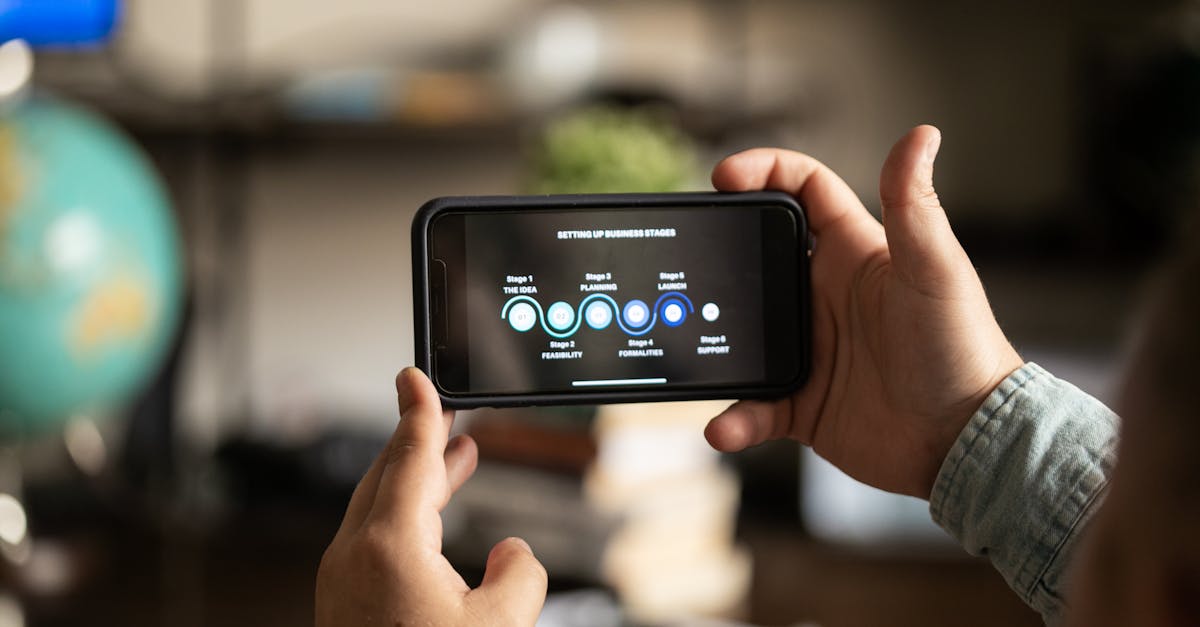In a world where your fridge can text you when you’re out of milk, IoT mobile app development isn’t just a trend—it’s a revolution. Imagine controlling your home’s thermostat from the beach or getting alerts about your garden’s hydration levels while you’re at work. Sounds like science fiction? Well, it’s happening right now, and it’s time to jump on this tech train before it leaves the station!
Developing IoT mobile apps is like crafting a digital Swiss Army knife. These apps connect devices, streamline processes, and make life a whole lot easier. Whether it’s enhancing smart home experiences or optimizing industrial operations, the possibilities are endless. Dive into the fascinating world of IoT app development and discover how it’s shaping the future, one smart device at a time.
Table of Contents
ToggleOverview Of IoT Mobile App Development
IoT mobile app development involves creating applications that connect and control a variety of devices. This technology enables users to interact with smart devices seamlessly. Developers design interfaces that allow real-time monitoring and management, offering users convenience and efficiency.
Applications span many industries, including healthcare, agriculture, and smart homes. In a smart home setting, users can control lighting, security systems, and temperature through their smartphones. Solutions in healthcare facilitate remote patient monitoring and wearable device integration, enhancing patient care.
Developers often use robust frameworks and programming languages for IoT apps. Common choices include Node.js, Python, and Java. These technologies help ensure secure and scalable applications tailored to user needs.
Integration with cloud services is essential for data storage and processing. Cloud platforms such as AWS, Azure, and Google Cloud provide the infrastructure necessary to manage vast amounts of data generated by IoT devices. Leveraging these platforms allows for efficient data analytics and insights.
Security remains a top priority in IoT app development. Vulnerabilities can arise due to the interconnected nature of devices. Developers implement encryption, secure authentication, and regular updates to mitigate risks.
Testing and quality assurance are critical components throughout the development cycle. Comprehensive testing processes identify and resolve issues before deployment. These measures help maintain functionality and user satisfaction.
As technology evolves, IoT mobile app development is poised to expand further. Trends like edge computing and artificial intelligence influence the landscape. Continuous innovation in this sector presents new opportunities and challenges that developers must navigate.
Importance Of IoT Mobile App Development
IoT mobile app development plays a crucial role in today’s technology landscape. These applications connect devices and enable users to manage them effortlessly.
Enhancing User Experience
User experience improves significantly with IoT mobile apps. Applications allow individuals to control smart home devices from anywhere. For instance, adjusting lighting or temperature settings occurs instantly from a smartphone. Notifications about appliance statuses keep users informed, enhancing reliability. It’s common for users to integrate various devices, creating personalized ecosystems that cater to unique needs. Voice commands through apps streamline interactions, making device management more intuitive. Innovative designs and features keep users engaged and satisfied, driving further adoption of smart technologies.
Driving Business Efficiency
Business efficiency experiences a boost through IoT mobile app development. Enterprises utilize apps to monitor operations and track assets in real-time. Automation of routine tasks reduces manual intervention, lowering operational costs. Data gathered from connected devices aids in making informed decisions faster. For example, predictive maintenance in manufacturing helps identify issues before they escalate, minimizing downtime. Employees benefit from streamlined workflows and enhanced collaboration, as communication occurs seamlessly across connected devices. Overall, integrating IoT solutions positions businesses competitively, driving growth and innovation in various industries.
Key Technologies Used
IoT mobile app development relies on various technologies to ensure seamless connectivity and functionality. Key components include IoT protocols and robust mobile development frameworks.
IoT Protocols
Protocols designed for IoT applications play a crucial role in enabling device communication. MQTT stands out for its lightweight messaging and efficient use of bandwidth, making it ideal for low-power devices. Another common protocol is CoAP, which facilitates web transfer in constrained networks, enhancing interoperability among devices. WebSocket creates persistent connections, allowing for real-time communication. Implementing these protocols ensures devices interact effectively, delivering timely data and promoting a more integrated user experience.
Mobile Development Frameworks
Frameworks for mobile development simplify the creation of IoT applications, allowing developers to build efficient and scalable solutions. React Native offers a cross-platform approach, enabling the same codebase to function on both iOS and Android, saving time and resources. Flutter, developed by Google, provides high-performance mobile applications through its widget-based architecture. Native programming languages like Swift for iOS and Kotlin for Android also play a significant role, ensuring optimized performance. Selecting the appropriate framework enhances the app’s performance, responsiveness, and user satisfaction.
Development Process
The development process of IoT mobile applications consists of several critical phases. Each phase contributes to creating an effective and secure app.
Planning And Design
Planning and design lay the groundwork for a successful IoT mobile app. During this phase, developers identify the target audience and define user requirements. Understanding device interactions and application functionalities drives the design choices. Wireframes and prototypes visually represent app navigation and features. Feedback from stakeholders helps refine concepts before development begins.
Implementation And Testing
Implementation moves the project from planning to a tangible product. Developers write code using selected programming languages such as Node.js, Python, and Java. Integration with cloud services like AWS, Azure, and Google Cloud occurs at this stage for efficient data management. Testing follows implementation to ensure functionality and security. Various tests, including compatibility and performance assessments, address potential issues early. Quality assurance remains essential throughout the process to deliver a reliable application.
Challenges In IoT Mobile App Development
IoT mobile app development presents several hurdles that developers encounter during the process. Understanding these challenges is essential for creating efficient and secure applications.
Security Concerns
Security ranks as a top priority in IoT mobile app development. Developers must navigate various vulnerabilities that can expose sensitive data, such as user information and device controls. Implementing robust encryption methods is crucial. Secure authentication processes help to verify user identities and prevent unauthorized access. Regular security updates also protect applications from newly discovered threats, ensuring ongoing safety. Many developers employ security frameworks and perform penetration testing to identify and fix potential weaknesses. Without addressing these security concerns, user trust and app functionality could suffer significantly.
Device Compatibility Issues
Device compatibility affects the performance of IoT applications. Different manufacturers deploy varying standards and protocols, leading to integration challenges. Ensuring seamless communication across devices becomes critical to delivering a cohesive user experience. Developers often need to tailor applications to operate across multiple platforms. Testing applications on various devices is a vital step that identifies and resolves compatibility issues. Utilizing flexible frameworks can streamline this process, accommodating diverse device types. A thorough understanding of device capabilities enhances the application’s efficiency while ensuring smooth interoperability across the IoT ecosystem.
Future Trends In IoT Mobile App Development
Emerging trends in IoT mobile app development shape how users interact with technology. Integration of artificial intelligence enhances app capabilities, allowing for smarter functionalities and personalized user experiences. Machine learning algorithms analyze data from devices, resulting in more efficient automation and improved decision-making.
Another significant trend involves edge computing, which processes data closer to devices rather than relying solely on the cloud. This reduces latency, enhancing real-time interactions and improving user satisfaction. For instance, smart home devices can respond instantly to user commands, creating a seamless experience.
5G technology is also set to revolutionize IoT applications by providing faster and more reliable connections. Increased bandwidth allows multiple devices to communicate simultaneously without performance degradation, facilitating the growth of smart cities and advanced industrial automation.
Security measures continue to evolve, addressing vulnerabilities inherent in connected devices. Adoption of blockchain technology offers new solutions for secure data transactions, ensuring user information remains protected. Enhanced authentication protocols, such as biometrics, also reinforce security in IoT applications.
Focus on sustainable technologies gains momentum as developers strive to create energy-efficient applications. Optimization of device performance reduces energy consumption, contributing to environmentally friendly practices.
User experience design plays a crucial role in IoT mobile app development. Intuitive interfaces and simplified navigation are priorities, ensuring that individuals can manage devices with ease. Voice control features also become increasingly common, making interactions more natural.
As these trends unfold, IoT mobile app development continues to evolve, positioning itself as a critical driver of technological advancement across industries.
Conclusion
The future of IoT mobile app development is bright and full of potential. As technology advances developers are poised to create even more innovative solutions that enhance user experiences and streamline operations. The integration of emerging technologies like artificial intelligence and edge computing will further elevate the capabilities of IoT applications.
Security and compatibility will remain paramount as developers navigate the complexities of diverse devices and data protection. With a focus on user-friendly designs and intuitive interfaces IoT mobile apps will continue to transform everyday life and business practices. Embracing these advancements will not only improve efficiency but also foster a more connected and intelligent world.



